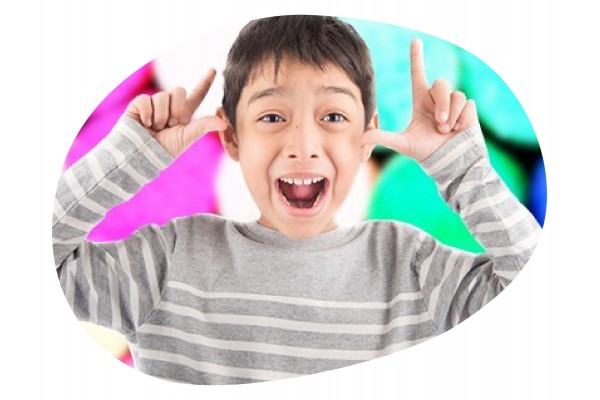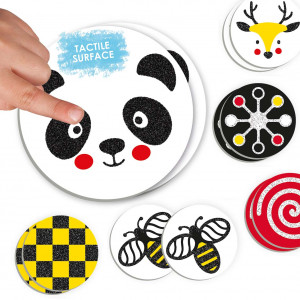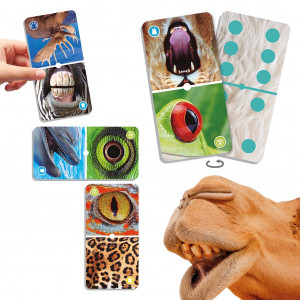Hearing impairment
The hearing impaired or hearing impaired child learns to use the rest of his or her senses to get to know the environment and interact with others.
Games should help the child integrate, communicate with others, and of course, be more autonomous. They will be part of your development and encourage you to explore further.
We present this selection of sensory games, which will allow you to experiment with the rest of your senses, exercising observation and association of concepts, psychomotor skills, facial expressions and language.

Games for deaf children
Parents and educators can organize activities for children through fun and varied games that stimulate their learning and use of other sensory areas. The games will be developed individually so that the child can strengthen his or her self-esteem and knowledge of the subject matter covered by the activity.
The group games will also help the children feel integrated. This integration is most effective when the group is made up of young children with and without disabilities. The only requirement to be taken into account is the adaptation of the activities for the play of all children under equal conditions. The purpose of the game is the acceptance by the group of children with different abilities.
How to design activities for deaf children
Ideally, we should know the sign language, so that we can understand and make ourselves understood correctly.
However, there are a number of activities that can be designed for hearing impaired children, which help them to integrate into the group and avoid the risk of exclusion.
Individual games for deaf children
We can organize individual activities for hearing impaired children, helping us with some games that allow the development of other sensory areas of the child.
In this way we will be promoting the capacities that it presents, and in addition we will stimulate the learning of the child by means of amusing and varied games.
Activities for hearing impaired children, which are developed on an individual basis, serve to reinforce the child's knowledge of the subject matter of the game itself, and as a basis for increasing self-esteem.
Games for deaf children in the classroom
It is very important that the child with a disability feels integrated, so group activities are essential, especially when they are groups of children with disabilities and children without disabilities.
However, we must always organise these types of activities in such a way that they are adapted to everyone, and if the rules of the game need to be modified to make it a fair activity for everyone, it is done without any problem.
The purpose of these activities is not to get a trophy, nor to win a competition, but to gain acceptance by the group of the child's disability, as something normal to adapt to in order to continue.
The best activities to teach deaf children
In Akros we want to recommend some of the games and toys that you can buy in our store, to work with hearing impaired children.
Below we show you some of the most interesting ones.
Recognize and express emotions
Children go through every imaginable state of mind in the same day, from the most complete joy to the most absolute frustration in just a few moments.
Sadness, joy, rage, anger, anger,... are part of those moods that they must show and that, although they themselves do not understand, they must allow to emerge.
Sharing their emotions helps them feel more understood, which can also help them avoid tantrums and control their behavior.
Children have to experience all these emotions because they will be part of their emotional base and we have to help them understand and cope with them.
- Expressions: This game helps them to identify different expressive icons, which show different types of emotions. Children learn to associate these icons with real images that show expressions.
- Emotion Puppets: This game helps children discover emotions. It is composed of several puppets and allows you to work with them to interpret the different emotions. The game includes a CD with two stories, which can be used by the adult or other children to help them express themselves and interpret it with their emotions in front of the child with a disability.
Games of the senses: smell
A game that helps them to develop their sense of smell, identifying smells and aromas of different fruits.
In this way it develops the senses that the child has fully active to compensate for the deficiencies in others.
Speech Development Games for Everyone
Remember that many games can be played even if you are hearing impaired, since not all of them require all five senses to be performed, but there are many observation games to encourage concentration, which do not need any kind of support or adaptation for deaf children.
- Association games: The child will have to demonstrate a great capacity of memory, observing, associating and learning the existing relation between the objects that are shown to him by means of letters or cards.
- Find the differences: These are games with practically identical pairs of photographs in which children must find the existing differences. It helps them stay focused, retain information and pay close attention to the task at hand.
The importance of play for hearing impaired children
Children with hearing problems acquire as much cognitive and intellectual development as other hearing children. Their way of learning will be at a different pace, more leisurely. The rhythm of their teaching is marked by elements such as their level of hearing, the time when the hearing loss occurred, and access to a shared communication system.
The child will mature his or her relationship with reality unevenly without being prevented from reaching the same (and even higher) level of performance as other people. At first, those games of attention and planned strategy will be less accessible to you, depending on your age and level of hearing loss.
Types of hearing impairment in children
Hearing impairment may be present at birth or develop later in childhood or adulthood. The symptoms of hearing loss can vary depending on the cause. Hearing loss may develop gradually over time, especially for factors associated with noise exposure and age.
Types of hearing loss
There are 3 main types of hearing loss:
- Conductive hearing loss. It is the one that occurs when sound is not efficiently transmitted into the outer ear. Conductive hearing loss generally decreases hearing acuity and sounds are perceived as weak. The most common causes are blockage of a wax plug, or fluid buildup from an ear infection.
- Sensorineural hearing loss reduces the ability to hear soft sounds. This is the most common type of permanent hearing loss. It occurs when there is damage to the hair cells in the inner ear (cochlea) or nerve pathways. Sensorineural hearing loss is often the result of aging or trauma.
- Mixed hearing loss. It occurs when there is simultaneous damage to the middle or outer ear and the inner ear (cochlea) at the level of the auditory nerve.
Degrees of severity of hearing impairment
The level of hearing loss in a hearing person is determined by testing. It consists of determining the minimum volume of sound the patient is capable of hearing, measured in decibels (dB). Some hearing disorders, such as tinnitus, do not necessarily involve hearing loss. There are 4 levels of hearing loss:
- Mild hearing loss (acoustic deficit between 25 and 39 dB). Mild hearing loss can sometimes make it difficult to follow a speech, especially in a noisy environment.
- Moderate hearing loss (acoustic deficit between 40 and 69 dB). The patient may have difficulty following a conversation or speech without a hearing aid.
- Severe hearing loss (acoustic deficit between 70 and 89 dB). People usually have to use some form of alternative communication, such as lip-reading or sign language, also with the use of a hearing aid.
- Deafness or profound hearing loss (acoustic deficit greater than 90 dB). People completely unable to hear a sound. Patients can often benefit from a cochlear implant.
The sound intensity of some common noises
The following comparison chart shows some familiar sounds along with the noise they generate. Sounds in the 100 dB range can cause hearing damage. The table below shows the damage that can be caused by continued exposure to certain intensities and the extent of the patient's hearing acuity in hearing tests.
Safe range
- 20 decibels. Ticking clock.
- 30 decibels. Speak in a whisper.
- 50-60 decibels. Sound of a conversation at normal volume.
- 80 decibels. Sound of an alarm clock alarm.
Range of risk
- 85-90 decibels. Noise from a hair dryer.
- 100 decibels. Noise of a rock concert.
- Up to 130. Noise from a jackhammer on a construction site.
Range of injury
- 120 decibels. Sound of an ambulance siren
- 140 decibels (pain threshold). The sound of an airplane's engines taking off.
- 180 decibels. The launch of a space rocket.
Symptoms of hearing impairment
Signs and symptoms associated with hearing loss may include
- Certain sounds seem muffled.
- Certain words are difficult to understand. You can't follow conversations well either, especially when there is background noise.
- Often interlocutors are asked to speak more slowly, louder or clearer.
- The person needs to increase the volume of the TV or radio.
- Dizziness or feeling of lack of balance, such as in cases of Ménière's disease or acoustic neuromas.
- You feel pressure in your ear from fluid changes behind the eardrum.
- ringing in the ears (tinnitus)
Signs of hearing loss in children
Children can have their hearing tested in the first few weeks after birth. However, some signs may suggest you consider further evaluation, for example, if you notice the following signs in your child:
- The baby is not frightened by loud noises.
- During the first eight weeks of life, the child does not generate spontaneous sounds.
- The child is delayed in learning to pronounce his or her first words, or is not clear when he or she finally speaks. Learning disability does not mean mental retardation. It consists of the fact that the child takes longer to learn something in relation to the average number of children of his or her age.
Conductive hearing loss in children
This condition is often caused by an obstruction that blocks the ear canal. Conductive hearing loss involves a reduction in the level of sound perceived by the child, or the inability to hear weak sounds. It occurs when sounds are unable to reach the inner ear. The most likely causes of conductive hearing loss are:
- Absence or malformation of the atrium, middle ear canal, or ear.
- Presence of middle ear fluid.
- Infection of the ear, such as otitis media; or of the ear canal, such as otitis externa.
- Allergy, such as serous otitis media.
- Certain benign tumors.
- Gradual accumulation of cerumen. It can block the ear canal and prevent proper conduction of sound waves. A wax plug causes mild hearing loss in people of any age. The simple remedy is to remove excess earwax.
- Perforation of the eardrum. This is the rupture of the tympanic membrane due to changes in pressure (diving), infection or trauma.
- It is the hardening of the stirrup in the middle ear that makes sound transmission less effective.
Childhood Sensorineural Hearing Loss
It occurs when hair cells within the cochlea or related nerve pathways (inner ear) are damaged. The conditions may be, among others:
- Congenital deafness that manifests itself at birth or over time. It is due to genetic factors, such as Down syndrome, or certain complications during pregnancy or childbirth.
- Non-hereditary factors, such as gestational diabetes, neonatal asphyxia (lack of oxygen at birth), severe jaundice in the neonatal period (may damage the auditory nerve in the newborn).
- Acoustic trauma from prolonged exposure to loud noises causing inner ear injury. Head trauma.
- Presbycusis, or age-related hearing loss due to degeneration of sensory cells.
- Infectious diseases of childhood that affect the inner ear, such as mumps; or the auditory nerve, such as measles.
- Chronic otitis. In addition to causing hearing loss, in certain patients it can also cause life-threatening complications, such as meningitis.
- Ménière's syndrome. Associated with tinnitus, it causes ear obstruction, dizziness and hearing loss.
- Acoustic neuroma. Benign tumor affecting the auditory nerve.
- Neurological disorders such as strokes, or ALS. Multiple Stroke and \ stroke can have an effect on the audience.
- The use of ototoxic drugs at any age.












































